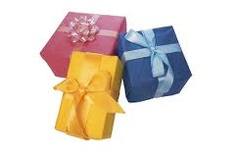Only Three gifts

We went to see our children’s nativity play at school the other day. Sam was Joseph, Ben was Gabriel and Tom was the King proffering gold. (A Hancock takeover?!)
The fact that Jesus was given three rather special presents to celebrate His birth really struck me.
I was reading an article by Amy Wagner recently that I found really inspiring and interesting. She described how she had found a bin-bag full of wrapped presents hidden under a blanket on her washing machine four days AFTER Christmas.
She had not even noticed that her children had not had these presents, even though they were from her! It suddenly dawned on her how excessive her present-buying had become and she felt compelled to do something about it.
She said, ” As I looked back on pictures of past Christmas Days, I realised that my girls were dazed by present-overload, not knowing what to play with first and just sitting there in the midst of the jumble of gifts and wrapping. This was not good.”
That is when she hit on the idea of giving three gifts to each child in honour of the three gifts the Wise Men gave Jesus that first Christmas. When she shared her ‘epiphany’ with her husband, he decided that they should also give three gifts to each other. They then sat their children down and explained the new way they wanted to do Christmas, as well as the reasons why they wanted to go this different direction. Thankfully, the kids were totally on board. Thus, a new family tradition was born.
Each family member now receives a “Gold Gift.” The Gold present is something that child really wants and is the most valuable of the presents. The family wrap the present in gold paper and tie it with a big gold ribbon.
Next is the “Frankincense Gift.” Frankincense is a spice that was burned as incense in the Temple during Jesus’ time. For her family, the Frankincense Gift is a gift that will draw the person closer to God, such as a Bible study book, a devotional, worship music CD, or Christian fiction.
The last gift is the “Myrrh Gift.” In Biblical times, myrrh was one of the ointments used to embalm the dead and was said to have been one of the spices carried by Mary to the tomb to anoint Jesus’ body. For this lady’s family, the Myrrh Gift is one that covers the body, such as clothing or bath products, special soaps, lotions or perfume.
A close friend who decided to adopt this tradition too, gave the family packages of hardened frankincense and myrrh. Amy separated the hardened, sweet-smelling resins into material pouches tied with ribbon, to which she added a tag describing the significance of the gift. Each year these special tags adorn each person’s present.
This lady’s children love this tradition and share with others the special way the family ‘do Christmas.’ Never once have the children felt neglected or that it was unfair that they each receive ‘only’ three gifts. They have become great at tweaking their own lists for Christmas under the “three gifts” guidelines and have made their Mum’s Christmas shopping much easier and less stressful. All of the children have even stated this is a tradition they will pass down to their own families some day.
I read this and felt very inspired.
A couple of years ago, Jon and I decided that we would not give gifts to our children at Christmas, except a token stocking. We also decided not to buy presents for friends and relatives (explaining this!) sticking to one small gift each and instead give the money to a worthwhile Christian Charity.
I was stunned the first year that we did this.
By not buying aftershave, socks, recipe books and ties for people who then put them in a drawer, we raised £1897 in the first year which bought an orchard, text books, a field, a year’s supply of maize and many other things for a village in the developing world.
As my children grow up, I want them to associate Christmas with GIVING and not GETTING.
I love the three gifts idea and may suggest we adopt that for next year…
How about you?
